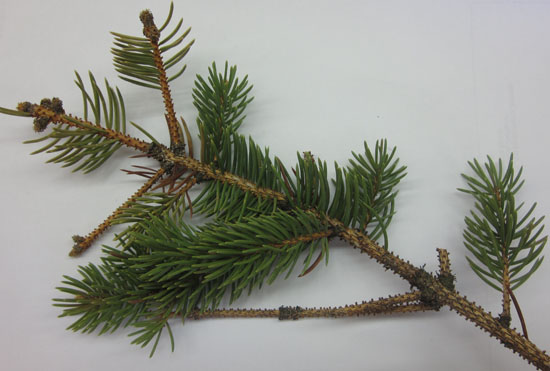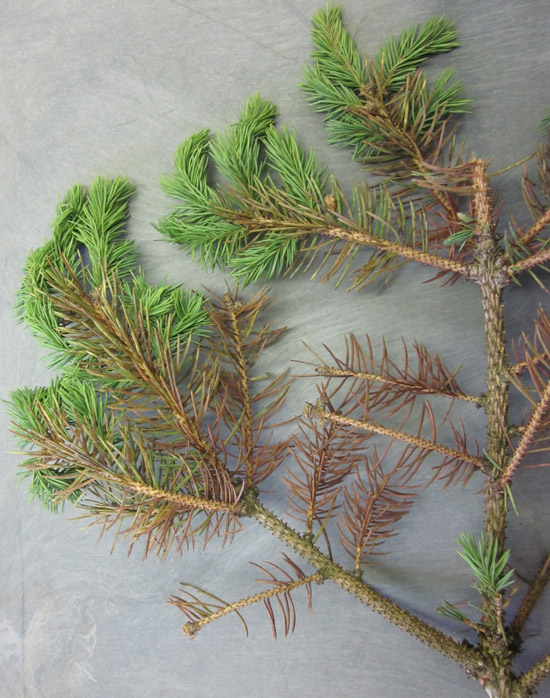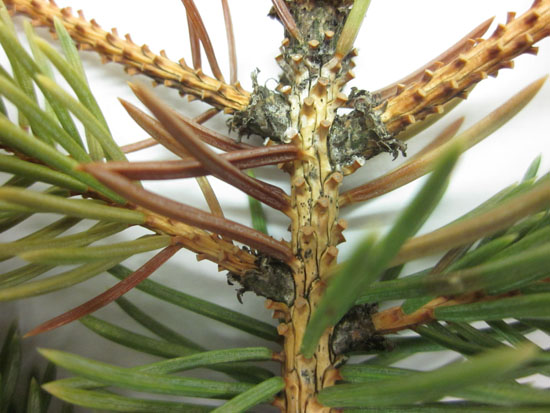Issue 6, May 31, 2011
New Disorder of Spruce in Illinois: Sudden Needle Drop of Spruce (SNEED)
The University of Illinois Plant Clinic has received spruce samples from both central and northeastern Illinois that have been diagnosed with Sudden Needle Drop (SNEED) caused by Setomelanomma holmii. While SNEED has been found in several surrounding states, this is a first find in Illinois. We are pursuing independent identification since this is a first find as well as proceeding with qPCR analysis for verification.
SNEED has been found on Norway, white and Colorado blue spruce trees. Symptoms of SNEED are yellowing and eventual browning of older needles. Typically, by the end of summer, all of the needles on affected branches fall off except the newest needles on the tips of the branches. Symptoms being noticed now in the spring are nearly defoliated branches that may still have a few brown or half brown needles attached or no old needles and just new bud growth. Branches affected by needle drop may be scattered throughout the tree or the entire tree may be affected.

SNEED symptoms on spruce, missing needles (photo credit Diane Plewa)

SNEED symptoms, spruce branches with brown second year needles and new needles (photo credit Diane Plewa)

Small black fruiting structures of SNEED on spruce branches (photo credit Diane Plewa)
Unlike our other common fungal needle cast diseases the fungus doesn't produce fruiting structures on the needles. While spruce needles don't show signs of fungal infection, the twigs will have numerous small black fruiting structures (pseudothecia). They are not lined up in any particular pattern. According to diagnosticians in Missouri, the fungus produces pseudothecia early in the season until about July. Then another type of fruiting structure called a 'pycnidia' produces small clear spores called 'micro-conidia'. We have found both pseudothecia and the probable micro-conidia on our samples in May.

Close- up black fruiting structures on spruce branch (photo credit Diane Plewa)

Ascospores of SNEED from crushed fruiting structure 400X (photo credit Diane Plewa)
Although, the fungus is found infecting symptomatic trees there is still a question whether it is a pathogen. It may indeed be a pathogen or may simply be a fungus taking advantage of a tree stressed by drought, heat, poor planting or other environmental factors. Researchers at the University of Wisconsin are pursuing pathogenicity tests with the fungus to verify or negate it as a pathogen.
To help with field diagnosis for sampling, note that SNEED fruiting structures will not be on the affected needles. If you do see fruiting structures on the needles of a symptomatic spruce, you are most likely looking at either Stigmina or Rhizosphaera or another fungal needle cast. A tree can have just one of these needle casts or two or more.
Management recommendations are sparse; Bruce D. Moltzan of the Missouri Department of Conservation indicates that fungicides for control of Rhizosphaera needle cast can provide control in nurseries and smaller landscape trees.
For more information contact Suzanne Bissonnette, University of Illinois Plant Clinic 217-333-0519. (Suzanne Bissonnette and Diane Plewa)
Author:
Suzanne Bissonnette